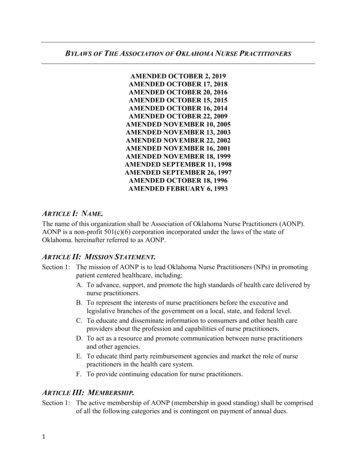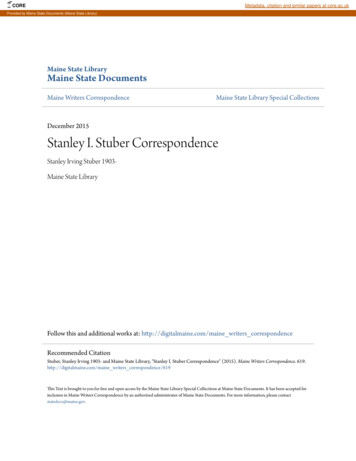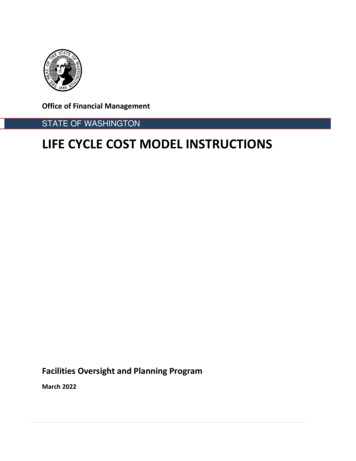
Transcription
Office of the State TreasurerDebt Management SystemDisaster Recovery PlanRelease 1.4
Acceptance of Disaster and Recovery Plan DeliverableOffice of The State TreasurerDMS PHASE ISOT001Accepted by:Office Of The State TreasurerProject ManagerOffice Of The State TreasurerAccepted by:DateDateDateDate
Revision HistoryDateDescriptionDraft (Version 1.0)06/19/2003Version 1.107/14/2003Version 1.2 (Revisions)07/18/2003Version 1.3 (Revisions)09/08/2003Version 1.4 (Revisions) [FINAL]Author
Table of Contents1. Introduction and Objectives52. Production and Standby Server Configuration6The following is the configuration for the Production Database Server andApplication Server:73. Traditional Backup vs Standby Server84. Overview of Oracle Standby Database95. DMS Disaster Recovery Implementation96. DMS Disaster Recovery Maintenance127. DMS Disaster Recovery Operation138. Return to Normal Operations179. Test Plans1910. Vendor Support2211. Technical References23
1. Introduction and ObjectivesDebt Management System (DMS) is a web-based multi-tiered application: Its core componentsare the Oracle Database and Application Server; therefore, the main focus of this documentdescribes the process of backing up and protecting an Oracle database; the development andimplementation of the Debt Management System’s Disaster Recovery Plan (DMS-DRP) shouldbe part of STO’s day-to-day activities.The primary objective of the DMS DRP is to enable STO to survive a disaster (as defined in theSTO Enterprise Disaster Recovery Document) and continue close-to-normal servicing andoperations. The two most important requirements are: To restore and make accessible to end users the critical and vital operating environmentsand data described in the DMS-DRP within 48 hours of a disaster declarationTo assist STO in accomplishing a speedy, orderly return to normal production operations,while complying with the Department of Information Technology (DOIT) standardsIn order to survive, the organization must assure that critical operations can resume/continuenormal processing. Throughout the recovery effort, the plan establishes clear lines of authorityand prioritizes work efforts. The key objectives of the contingency plan should be to: Continue critical business operationsMinimize the duration of a serious disruption to operations and resources (bothinformation processing and other resources)Facilitate effective co-ordination of recovery tasksReduce the complexity of the recovery effortDocument a detailed process so that if the system is operational, there is a processidentified to walk the user through getting the system back upThe roles and responsibilities for STO IT staff for the execution of the disaster recovery planwill be as defined in the Enterprise Disaster Plan for STO. Staff from the STO IT and theTechnical Support will be identified to perform the execution of this plan.
AssumptionsThis document is based in the following assumptions and conditions: This is NOT a simple “backup here, restore there solution” This is NOT an Enterprise-wide backup strategy This is a very specific solution to increase the availability of an application, by having asingle Standby server in a different geographical location, waiting to be activated toreplace the functionality of several others, in case of a disaster Servers and systems switchover to the redundant unit(s) will NOT occur automatically; itrather requires some administrator’s and end-user’s interaction/configuration DMS (and its Oracle database) will be running 7x24 The redundant systems will function degraded-mode information processing activitiesuntil the problem is resolved The redundant server and required software will be located at Daily tape backups of the DMS server(s) will be taken to a secured site/location. Thesetapes are to be shipped to the redundant facilityin the event of an emergency;production data of the redundant site is within 24 hours of being synchronized with theproduction site A permanent LAN/WAN link exists between the Sacramentoconnect to each other during non-emergency conditionssites; servers can2. Production and Standby Server ConfigurationThe following software is required for the Standby Database Server: Windows Terminal Services Oracle Oracle Oracle VeritasAnd the hardware configuration:VendorBase UnitProcessorMemoryHard DriveHard DriveControllerOperatingDescriptionItem #Part #
ures (1)MiscellaneousSupportDescriptionItem #Part #Support(2)The following is the configuration for the Production Database Server and ApplicationServer: WindowsTerminal ServicesOracleOracleOracleVeritasAnd the hardware configuration:VendorBase UnitDescriptionItem #Part #ProcessorMemoryHard DriveHard ionalStorageProductsFeatures (1)MiscellaneousSupportSupport(2)The Client Access Licenses for Windows will not impact the number of users accessing theapplication via the Web interface.
3. Traditional Backup vs Standby ServerA study published by Comdisco Recovery Services, Inc. shows the recovery times using differenttechniques, including the Traditional Backup/Restore and Standby Database Server. The chart isbased upon several actual customer data.The horizontal axis shows the time of failure as “0 Hours”, with Hours of Lost Transactions(Recovery Point Objective) to the left (negative) and Hours Required to Resume Business(Recovery Time Objective) in the positive range.In the Traditional Recovery approach: Nightly backups are performed Courier services pick up the backup media from the production site daily Tapes are stored at a secure location, which is usually not the Recovery Site In the event of a failure of the Production Site, backups are restored, then Redo Logs areapplied to re-build the database The recovery process is very long and moderately difficult A high number of transactions is lostIn the Standby Database approach: The Redo Logs are continuously shipped and applied to the dedicated Standby systemas they are created Automated log shipping can be used to send the archive logs Finally, the Standby System must be reconfigured to become the Production System Full backups are still recommended at the Sites The recovery process is very fast and moderately difficult A very small number of transactions is lostOracle Standby Database performing continuous application of Redo Logs is the disasterrecovery solution most frequently used for Oracle mission critical applications. While a HotStandby provides slightly higher improved fail-over characteristics, a Standby Database is easierto implement and does not require application program modification.
4. Overview of Oracle Standby DatabaseAn automated Standby Database provides a means to create and maintain a remote copy of aproduction Database. The Standby Database can take over processing from the primaryProduction Database, providing near continuous database availability.Under normal conditions: The Production Database is servicing the clients and sending the Redo Logs to theStandby Database The Standby Database is in constant Recovery Mode, applying the archive logs toensure proper synchronization with the Production DatabaseWhen a catastrophe occurs: The Production Database is NO longer available The Standby Database is reconfigured for servicing the clients and opened in read/writemode. Once this process has occurred, the database can NOT be put back to theStandby modeWhile a Standby Database can also be used as a read-only database, to temporarily off-loadquery processing from the production database, such process does not directly relate to DRP andwill not be discussed in this document.It is imperative that the production database be run in archive log mode and that the archivedredo logs are archived to a suitable media so that they can be used for recovery. The DBA unit ofSTO must take “Hot” backups of the production database on a daily basis.5. DMS Disaster Recovery ImplementationDMS consists of three interacting components: Supporting Operating System and Servers (database/application) DMS data (stored in the Oracle Database) And DMS application, programs, reports and formsTo successfully implement a Primary-Standby Database synchronization schema, the followingconditions exist: Primary and Standby Databases must reside on the same hardware typeand base operating system The database versions should also be identical; at the very least, Standby and Primarydatabases should never cross major releases The init.ora parameter compatible must be identical, and configurations with differentreleases need to be tested and validated.Then, a simple 3-phase implementation process begins: Preparation and configuration of the Primary Site (STO – Sacramento)
Shipment of filesPreparation and configuration of the Standby SiteThe standby database will be created using the automated tool “Data Guard”, provided with theOracle Enterprise Manager (OEM). Oracle Data Guard is the management. monitoring andautomation software that automates the creation and subsequent maintenance of a standby copyof the primary (production) database. If the primary database becomes inactive, then the standbydatabase can be activated and can take over the data serving needs for STO.The Data Guard architecture incorporates the following items: Primary Database: which is the actual production database, running in archive log modeand which is used to create the standby. The archived logs from the primary databaseare transferred and applied to the standby database(s). Each standby database can beassociated with a single primary database, but a single primary database can beassociated with multiple standby databases. Standby Database: which is the replica of the primary database. Log Transport Services: Control the automatic transfer of archive redo log files from theprimary database to the standby database(s). Log Apply Services: Apply the archived redo logs to the standby database. Role Management Services: Control the changing of database roles from primary tostandby. These services include switchover, switchback and fail over. Data Guard Broker: Controls the creation and monitoring of the Data Guard. It comeswith a GUI or a command line interface.Data Guard currently supports two architectures: Data Guard Redo Apply Architecture (Physical Standby) Data Guard SQL Apply Architecture (Logical Standby) STO IT has decided to go in with the Physical Standby Architecture. In thisarchitecture;o The physical standby database is a block-for-block copy of the primarydatabase.o Uses the database recovery functionality to apply the changes made to theprimary.o Standby database can be opened in read only mode for queries/reporting.It is recommended to use the Redo Apply Architecture for the DMS for the followingreasons: Proven and robust apply mechanism. Support for all DDL and DML (with no restrictions of data types such asLONG, LONG RAW, ROWID, UROWID) and Table Types (NestedTables and VARRAYS). Note: These data types and table types are notsupported in the SQL Apply architecture. Performance: The Redo Apply technology applies changes using lowlevel recovery mechanisms, which bypass all SQL level code layers andtherefore is the most efficient mechanism for applying changes. Thismakes the Redo Apply a highly efficient mechanism to propagatechanges between databases. Oracle Data Guard also offers the flexibility to enable the physicalstandby database switch between recovery and read-only modes. E.g.running the database in recovery mode, then opening in read-only mode
to run reports, and then returning to recovery mode to apply outstandingredo data.An important consideration while implementing the standby database is the data protectionmode.Currently, Oracle Data Guard provides three modes for data protection.Protection ModeMaximum ProtectionZero data lossRedo ShipmentMode by Log WriterProcessSynchronousMaximum AvailabilityZero data lossSynchronousMinimal Data LossAsynchronousMaximumRisk of Data LossCommentsPrimary stopsprocessing if standbyunavailablePrimary stopsprocessing if standbyunavailableLeastimpacton
Performance(Default)(usually zero to fewseconds)performanceprimary database.ofSTO IT will select the maximum performance data protection mode as DMS is not a highlytransaction based system.At the Primary site, the following tasks are required: Setup the database in archive log mode. Setup the database in the Oracle Enterprise Manager Setupparametersnecessary forphysicalstandby database(example:COMPATIBLE,REMOTE PASSWORD FILE, STANDBY FILE MANAGEMENT etc.) Backup initialization file(s) and database files (RMAN) Backup DMS-related programs and files (all files underon theApplication Server) Document the locations and special settings of DMS-related programs and files, servicesand subsystems, as well as the Operating System.Setup the Data Guard configuration and identify the standby database; file locations for the datafiles and control files.At the Standby site, the following tasks are required: Using the documented configuration from the Production Site, install and configure:o The supporting Operating System, services and subsystems, including matchingservice patcheso Application and Database serverso DMS-related programs and files, insuring the locations correspond to the onesdefined at the Production site. Establish monitoring scripts using the inherent OEM Data Guard tools.(See examples inSection 9. Test Plans) Restore data files and standby control files (RMAN) Modify init.ora files Mount the Standby Database using the standby controlfile Initiate the Standby Database in recovery mode.6. DMS Disaster Recovery Maintenance Supporting Operating System and Servers MaintenanceAny upgrades, patches and new versions of the Operating System and Servers applied to theProduction servers must be also applied to the Standby server, in order to keep them consistent,as well as fully compatible and operational. A full hot Backup of the database must be takenbefore performing any such upgrade.When changes are done at the Production Site, these need to be fully documented, and thenpromptly reproduced and applied to the Standby Site. DMS Data MaintenanceAfter the Standby Database is created, it needs to be in recovery mode and continuously,applying archives to ensure changes from the Production are propagated to the Standby.Standby database maintenance should be automatic, so that propagation occurs quickly thusensuring that the Standby is very current with the Production. How closely the Standby concurs
with the Production Database depends on how quickly/often changes are propagated to theStandby, to meet STO’s service level requirements (MTTR).For example, if STO’s MTTR is 48 hours, the configuration of the total times to log switch, archivea log, propagate a log, and recover needs to be set to less than 48 hours.The maintenance cycle can be outlined as follows: Continue archiving to archive log files (Production Site) Monitor for any errors or NOLOGGING operations (Production Site) Transfer completed archive log files (from the Production to the Standby Site) Continue backing up the Production Database and shipping media to the Standby Site Continue applying archives to Standby Database Monitor for Standby Database status and errorsMaintaining a Standby Database imposes no overhead on the Production Database. Log files arenormally created by the Production Database to recover from a system failure and no extralogging is done to maintain a Standby Database.Any structural changes made in the Production database such as when new columns are addedto tables or data types changes; then these changes must be manually made in the standbydatabase as well. DMS Application, Programs, Reports and Forms MaintenanceAny modifications, upgrades, and patches performed to the DMS application and programs at theProduction servers, must be also applied to the Standby server, in order to maintain systemconsistency and integrity.These changes need to be fully documented, and then promptly reproduced and applied to theStandby Site. To accomplish this task, the following approaches exist: Fully automated scripts, that transfer the appropriated files and programs Over-the-Wire,from the Production to the Standby server On-site installation, where the physical media is sent to the Standby Site and installedlocally to the server.The automated scripts method works best if the DMS application is constantly being updated,since the update scripts can be set to run and apply changes as often as required.As a general rule for major upgrades and updates, a local (on-site) installation at the Standby Siteis always preferred, in place of Remote or Over-the-Wire installs; this practice works best toeliminate or minimize errors.7. DMS Disaster Recovery OperationThe Standby Site should necessarily be activated in case of a Disaster.While the Standby site could also be used to temporarily service the users in case of a plannedoutage of the Production Site (e.g. major software or hardware upgrade needing to get theProduction Site off-line), this document will not cover that switch-over option.
The following steps are required to activate the Standby Site: Assuming the Supporting Operating System and Servers have been properly updatedand maintained, nothing needs to done. In the unlikely event that a few upgrades have not been applied according to thedocumentation from the Production Site, those must be applied prior to switchingoperations to the Standby Site The above statements apply for the DMS Application, Programs, Reports and Forms At this point, the Standby Database can be configured to act as the New ProductionDatabase and start servicing requests at the Standby Site. The Oracle Data Guard “failover” functionality can be used to activate the standby database. Data Guard supports agraceful as well as a forced switch over. A graceful fail over is generally recommended asit attempts to minimize the data loss by finishing the application of unapplied logs. Aforced fail over is fast compared to the graceful method but makes no attempt to finishapplying of the logs. Finally, the DMS users can be switched to run the DMS application from the Standby Site(using the New Production Database). This task could be accomplished by either:o Instructing the users to re-point their applications to the new server, located atthe Standby Site. While this is a faster approach, its implementation needs someend-user interaction; oro Replacing the servers’ IP address of the Production Site (now defunct andunavailable) with the server’s IP of the Standby Site (now providing theProduction Database) via DNS updates. This method requires no end-userinteraction, but may be slower due to DNS propagationThe following screen-shots illustrate how the “fail-over” functionality is performed from the OEMData Guard once the physical standby configuration has been created.The screen-shot below indicates that there is a problem with the Primary Database as there is ared cross sign next to the Status column and the primary site cannot be reached.
If you determine that a failure has occurred on the primary database and there is no possibility ofrecovering the primary database in a timely manner, you can start the Failover wizard byselecting Failover on the Object menu.The following screen shows the list of available standby sites and the DBA will have to select thestandby site which will become the new primary site.
During the failover operation, the wizard opens a window to display the progress of the operationas it transitions the selected standby site into the primary role and restarts all online physicalstandby database instances involved in the failover operation. When completed, the configurationGeneral page reflects the updated configuration with the new primary site taking over. (Note : thestandby database is displayed as Primary and the earlier Primary database is displayed asstandby and its status is unknown.
NOTES:When a RESETLOGS operation occurs, the Primary and Standby Databases are no longercompatible. Previous redo is invalidated and cannot be applied. A new Standby Database (or theoriginal Production Database) needs to be re-built as soon as possible.Only new data will be entered to the New Production Database at the Standby Site, using theDMS applications and programs.In general, NO modifications to the Operating System or the DMS application should be allowedduring the emergency-mode operation at the Standby Site; if an update is absolutely required forthe proper operation of the Standby server, this has to be fully documented for future deployment,once the Original Production Site is reactivated.To improve Standby Site survivability, implement regular backups, following the techniques usedat the Original Production Site. Store the media at another location.It will be the STO IT DBA task to do database backups or to perform a manual switchover fromthe primary to the secondary site in case of a disaster. Network Support will be needed in casethere is a problem in the WAN/LAN communication links.8. Return to Normal Operations
Reconditioning of the original Production Site and servers must commence as soon as the siteand resources become available and are secure. Proper WAN connectivity is also required toadequately accomplish this task.If the Original Production Site was lost due to a LAN/WAN link failure: Test connectivity to the Standby Site thoroughly using terminal services or using theOracle OEM Data Guard Switchover functionality. Insure that any modifications applied to the Operating System, services and serversduring the interim operation, are replicated to the Original Production servers Same as above applies for the DMS application, programs and filesIf any of the servers at the Original Production site were lost due to hardware failure(s): Rebuild the failed hardware, according to the documented configuration Install and configure the Operating System, patches, servers, and services, as well as theDMS applications, programs, files, etc. as detailed in the documentation Test proper connectivity to the Standby SiteSynchronize the DMS data, from the Standby to the Original Production Site: A full hot or cold database (control files, database files, init.ora) backup of the ProductionDatabase (located at the Standby Site) needs to be shipped to the Original ProductionSite The Database server, located at the Original Production Site needs to be configured inStandby Database mode, as documented previously Backed up DMS data from the Standby Site needs to be loaded at the Production Site Activate the changes and run the Production Site’s Database server in Standby-mode,allowing the Standby Site to send updates Plan for a DMS service outage (during a weekend or after-hours, if possible) Perform a Controlled Switchover, turning the Production Site’s database as the currentProduction Database, effectively switching the Standby Site’s database to Standby mode Redirect the users/clients to the recently re-enabled Production Site, using either themanual or DNS-supported schemaTo Controlled Switchover: Standby Site: The Production Database must be properly SHUTDOWN Production Site: The Standby Database is updated with all the archived logs andSHUTDOWN NORMAL Standby Site: Online Redo Logs are sent to the Standby Site Production Site: A new controlfile is created; the Database is restarted, running now asthe Production database Standby Site: A new controlfile is created, enabling the database in Standby modeoperation. Then the database is mounted, effectively running in Standby mode, acceptingupdates and logs from the Production Site’s Database.Upon completion of the above procedures, the Production Site hosts again the ProductionDatabase, while the Standby database resides at the Standby Site, and the DMS application isback to its normal mode of operation and performance.New DMS Database and Application Server Configuration in case of a Disaster:In case, a new database server needs to be configured; then the following steps need to befollowed to setup the DMS Application: Install theOracle Database on the new Database Server.Generate the DMS Application from the Oracle Designer Repository or last backup.o
o This will generate the database objects (tables, views, indexes, packages and other DMSdatabase objects) as well as the application modules in terms of the forms, reports andlibraries.The database objects from the Designer Repository need to be created in the newdatabase created.Restore the data from the last export or any cold / hot backup performed.Setup the Batch Jobs on the Oracle OEM.In case, a new application server needs to be configured; then the following steps need to befollowed to setup the DMS Application: Install theon the new Application Server.Create a folder.Create sub-folders called Help, Template, ReportsCopy the forms (.fmx), reports (.rep) and libraries (.pll) from the Oracle DesignerRepository to a folderCopy the Online Help Files to the Help folder.Copy the Template Files for Reports under the Template Folder.The Reports Folder is designated for run time reports.9. Test PlansWhen the Disaster Recovery Server is configured; then the following tests should be performed: Before shipping the server too Test that the archive redo logs are transferred from the primary to the secondary.)o Test that the Failover and Switchover activities function correctly using theconfiguration set in the OEM Data Guard.o Ship the server to Los Angeles and setup the server with the pre-assigned IPAddress. After shipping the servero Test that the archive redo logs are transferred from the primary to the secondary.oTest that the Failover and Switchover activities function correctly using theconfiguration set in the OEM Data Guard.The Test Application is a good way to make sure that the configuration is set up andfunctioning properly before using live data and to test relative performance.Running the Test ApplicationYou use the Test Application dialog to help you evaluate the performance of your brokerconfiguration by adding and deleting rows in a test schema (eg.) on yourprimary database. To set up a Test Application, perform the following steps:1. On the Performance Page, click Options.
2. Click Start Test and start a test on the primary database (the default). You canalso select logical standby databases and physical standby databases that are inread-only mode.3. Click Setup at the bottom of the page to create the test tables.4. Choose Single Update Mode or Continuous Update Mode:Single Update ModeSingle Update Mode inserts one row of the value you specify into the Test Application. Touse Single Update Mode:On the primary database:5. Enter a value (using a VARCHAR datatype) in the text box under Single UpdateMode.6. Click Apply.On the physical standby databases:7. Set the state of the physical standby database to read-only mode.8. Click Options on the Performance Page and start another Test Application foreach physical standby database.5. View the Value field in the Test Application to see the inserted value.When the value from the primary database is inserted into the standby database, thevalue will appear in the Test Value text area of the Test Application started on the logical.Continuous Update ModeContinuous Update Mode inserts a number of insert and delete threads in the TestApplication. To set it up, select Options in the Continuous Update Mode section of theTest Application page and enter the number of Insert and Delete threads.More threads will produce more transactions resulting in more log traffic. The TestApplication will run until you click Stop or until there is a lack of resources. There are norestrictions on how many threads may be started and it is possible to exceed thehardware or database resource limits (which can also be a very useful test).The figure below shows the Test Application dialog for setting up single or continuousupdate mode tests.
STO IT must plan to test the Disaster Recovery Configuration (planned switch-over from primaryto secondary) as part of the preventive maintenance plan. This should be performed using theOEM Data Guard at least once in two weeks (or as per the Enterprise Disaster Recovery Plan forSTO) to ensure that the archived redo logs are getting shipped and applied correctly.For more in-depth performance and monitoring, you can display detailed performance statisticsfor a broker configuration using performance charts that provide a graphical summary of all redolog activity in the configuration. The charts are refreshed based on a collection interval (the rate atwhich data is sampled from the primary database) that you can specify.
10. Vendor SupportThe following table lists all vendors who can be contacted in case software licenses/upgrades areneeded in case of a disaster.Software/HardwareVendorContact Person/AddressPhone #
11. Technical References
The following is the configuration for the Production Database Server and Application Server: 7 3. Traditional Backup vs Standby Server 8 4. Overview of Oracle Standby Database 9 5. DMS Disaster Recovery Implementation 9 6. DMS Disaster Recovery Maintenance 12 7. DMS Disaster Recovery Operation 13 8. Return to Normal Operations 17 9. Test Plans .











